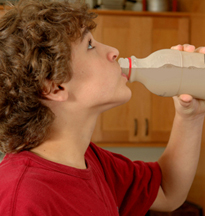 It's that time of year again. As the temperature slowly begins its decent to the inevitable winter lows, America's youth are headed back to the classroom. A few students throughout the country have had one of their favorite lunchtime beverages pulled from the menu: chocolate milk.
It's that time of year again. As the temperature slowly begins its decent to the inevitable winter lows, America's youth are headed back to the classroom. A few students throughout the country have had one of their favorite lunchtime beverages pulled from the menu: chocolate milk. For those who still have the option, their chocolate milk will have the same great taste, but it's taken on a healthier twist. According to the Milk Processor Education Program (MilkPEP), flavored milks in schools will have fewer calories and lower sugar content. On average, each carton of flavored milk will contain fewer than 150 calories and 22 grams of sugar.
After undergoing a five-year industry reformulation, flavored milk will have just 31 more calories than white milk. Flavored milk's makeover also reduced the sugar content in fat-free and low-fat chocolate milk by 38 percent.
As noted in the 2010 Dietary Guidelines for Americans, milk is a key source of the calcium, vitamin D, and potassium that is critical for childhood development. Most children, though, are in short supply of these nutrients. Consuming milk is the main way most children (and the majority of the American population) get these nutrients into their diets.
A National Health and Nutrition Examination Survey shows that flavored milk contributes a mere 3 percent of added sugars to kids' diets, while soda and fruit drinks account for nearly half of the added sugars.
MilkPEP also conducted an extensive study of milk processors who collectively serve 53 percent of K to 12 public schools. They found when the flavored milk option was removed, milk intake dropped drastically; 35 percent less milk is consumed where there is not a flavored choice.
By banning flavored milk, we may be doing more nutritional harm than good. When the option isn't there, students drink considerably less milk and miss out on nutrients essential for their development.








